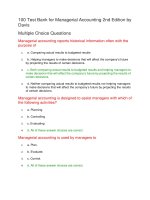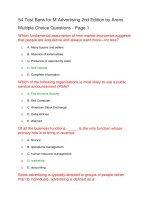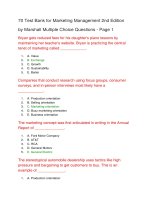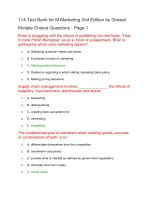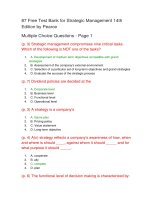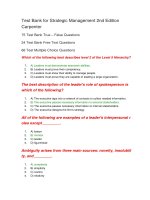Test bank for project management 2nd edition by pinto
Bạn đang xem bản rút gọn của tài liệu. Xem và tải ngay bản đầy đủ của tài liệu tại đây (89.4 KB, 22 trang )
Full file at />
Project Management, 2e (Pinto)
Chapter 1 Introduction: Why Project Management?
1.1 True/False
1) Projects, rather than repetitive tasks, are now the basis for most value-added in business.
Answer: TRUE
Diff: 1
Section: 1.0 Introduction
Skill: Factual
AACSB Tag: Reflective
2) Projects have a process orientation.
Answer: FALSE
Diff: 2
Section: 1.1 What Is a Project?
Skill: Definition
AACSB Tag: Reflective
3) A typical project stays within functional and organizational boundaries.
Answer: FALSE
Diff: 2
Section: 1.1 What Is a Project?
Skill: Definition
AACSB Tag: Reflective
4) The special nature of projects relieves project managers from their routine of planning,
organizing, motivating, directing, and controlling.
Answer: FALSE
Diff: 2
Section: 1.1 What Is a Project?
Skill: Factual
AACSB Tag: Reflective
5) A project exists outside of the standard line organization.
Answer: TRUE
Diff: 2
Section: 1.1 What Is a Project?
Skill: Factual
AACSB Tag: Reflective
buy this full document at
Full file at />
6) The initial goal and technical specifications of the project are developed during the planning
stage.
Answer: FALSE
Diff: 2
Section: 1.3 Project Life Cycles
Skill: Factual
AACSB Tag: Reflective
7) Client interest in a project is highest during the termination and conceptual phases.
Answer: TRUE
Diff: 2
Section: 1.3 Project Life Cycles
Skill: Factual
AACSB Tag: Reflective
8) The classic triple constraint standard for project performance is composed of time, cost, and
client acceptance.
Answer: FALSE
Diff: 2
Section: 1.4 Determinants of Project Success
Skill: Definition
AACSB Tag: Reflective
9) The business success dimension of project success determines whether the project achieved
significant commercial success.
Answer: TRUE
Diff: 2
Section: 1.4 Determinants of Project Success
Skill: Factual
AACSB Tag: Reflective
10) The Atkinson model for assessing project success gathers input from all of the project's
stakeholders.
Answer: TRUE
Diff: 2
Section: 1.4 Determinants of Project Success
Skill: Factual
AACSB Tag: Reflective
11) The use of benchmarking allows companies that are relatively immature at project
management to achieve quantum leaps of improvement.
Answer: FALSE
Diff: 2
Section: 1.5 Developing Project Management Maturity
Skill: Factual
AACSB Tag: Reflective
buy this full document at
Full file at />
12) Most effective project maturity models chart both a set of standards that are currently
accepted as state-of-the-art as well as a process for achieving significant movement towards
these benchmarks.
Answer: TRUE
Diff: 2
Section: 1.5 Developing Project Management Maturity
Skill: Factual
AACSB Tag: Reflective
13) Acme uses no recognizable project management processes and has entertaining project
meetings because each member has a unique way of reporting progress or lack thereof. Acme is
most likely at the moderate level in the generic project management maturity model.
Answer: FALSE
Diff: 2
Section: 1.5 Developing Project Management Maturity
Skill: Conceptual
AACSB Tag: Reflective
14) Any organization, no matter how initially unskilled in project management, can begin to
chart a course toward the type of project organization they wish to become.
Answer: TRUE
Diff: 2
Section: 1.5 Developing Project Management Maturity
Skill: Definition
AACSB Tag: Reflective
15) A company's culture has little impact on whether projects are successfully implemented.
Answer: FALSE
Diff: 2
Section: 1.6 Project Elements and Text Organization
Skill: Conceptual
AACSB Tag: Reflective
1.2 Fill in the Blank
1) A __________ refers to ongoing, day-to-day activities in which an organization engages while
producing goods and services.
Answer: process
Diff: 1
Section: 1.1 What Is a Project?
Skill: Definition
AACSB Tag: Reflective
buy this full document at
Full file at />
2) The goals of a project are sometimes called __________.
Answer: deliverables
Diff: 1
Section: 1.1 What Is a Project?
Skill: Definition
AACSB Tag: Reflective
3) Projects are __________-focused.
Answer: customer
Diff: 1
Section: 1.1 What Is a Project?
Skill: Factual
AACSB Tag: Reflective
4) Project management entails crossing __________ and __________ boundaries.
Answer: functional, organizational
Diff: 2
Section: 1.1 What Is a Project?
Skill: Factual
AACSB Tag: Reflective
5) In general, product life cycles are becoming __________ and product launch windows are
becoming __________.
Answer: shorter, narrower
Diff: 1
Section: 1.2 Why Are Projects Important?
Skill: Factual
AACSB Tag: Reflective
6) __________ serves as an excellent training ground for future senior executives in most
organizations.
Answer: Project management
Diff: 2
Section: 1.2 Why Are Projects Important?
Skill: Factual
AACSB Tag: Reflective
7) The stages in a project's development are known as the __________.
Answer: project life cycle
Diff: 1
Section: 1.3 Project Life Cycles
Skill: Definition
AACSB Tag: Reflective
buy this full document at
Full file at />
8) Detailed specifications, schematics, and schedules are all developed during the __________
stage.
Answer: planning
Diff: 1
Section: 1.3 Project Life Cycles
Skill: Definition
AACSB Tag: Reflective
9) Creativity is at its zenith during the __________ stage of the project life cycle.
Answer: execution
Diff: 2
Section: 1.3 Project Life Cycles
Skill: Factual
AACSB Tag: Reflective
10) The degree of risk associated with the project is at its highest during the __________ stage.
Answer: conceptualization
Diff: 2
Section: 1.3 Project Life Cycles
Skill: Factual
AACSB Tag: Reflective
11) The triple constraint of project success is __________.
Answer: time, cost, performance
Diff: 2
Section: 1.4 Determinants of Project Success
Skill: Definition
AACSB Tag: Reflective
12) Atkinson suggests that all groups that are affected by a project, otherwise known as
__________, should have a hand in assessing project success.
Answer: stakeholders
Diff: 2
Section: 1.4 Determinants of Project Success
Skill: Definition
AACSB Tag: Reflective
13) __________ are used to allow organizations to benchmark the best practices of successful
project management firms.
Answer: Project management maturity models
Diff: 1
Section: 1.5 Developing Project Management Maturity
Skill: Definition
AACSB Tag: Reflective
buy this full document at
Full file at />
14) The Center for Business Practices maturity model stage that describes project management as
an ad hoc process is __________.
Answer: Level 1 or Initial Process
Diff: 2
Section: 1.5 Developing Project Management Maturity
Skill: Factual
AACSB Tag: Reflective
15) In general, all project management maturity models agree that an organization that has
internalized all necessary project management principles and is actively seeking to move beyond
these in innovative ways is __________.
Answer: (project) mature
Diff: 2
Section: 1.5 Developing Project Management Maturity
Skill: Factual
AACSB Tag: Reflective
1.3 Multiple Choice
1) Which of the following types of activities is more closely associated with projects rather than
processes?
A) an activity that is ongoing
B) an activity that is day-to-day
C) an activity that uses existing systems
D) an activity that establishes its own work rules
Answer: D
Diff: 1
Section: 1.1 What Is a Project?
Skill: Factual
AACSB Tag: Reflective
2) Which of the following is accomplished through project management?
A) A cellular phone company activates a new customer's service.
B) An automotive manufacturer produces a day's quota of vehicles.
C) A software developer creates a new crash-proof operating system.
D) A retailer restocks the shelves after a day of brisk sales.
Answer: C
Diff: 1
Section: 1.1 What Is a Project?
Skill: Factual
AACSB Tag: Reflective
buy this full document at
Full file at />
3) A project typically has:
A) a defined start and end date.
B) a defined start date but no defined end date.
C) no defined start but a defined end date.
D) no defined start or end date.
Answer: A
Diff: 1
Section: 1.1 What Is a Project?
Skill: Definition
AACSB Tag: Reflective
4) The Project Management Body of Knowledge Guide definition of a project indicates that a
project is:
A) multifunctional.
B) temporary.
C) designed to consume human resources.
D) limited by a budget.
Answer: B
Diff: 2
Section: 1.1 What Is a Project?
Skill: Factual
AACSB Tag: Reflective
5) Project members may be from:
A) different departments.
B) other organizational units.
C) one functional area.
D) all of the above.
Answer: D
Diff: 2
Section: 1.1 What Is a Project?
Skill: Definition
AACSB Tag: Reflective
6) There is no such thing as a project team:
A) with a deliverable.
B) with an on-going, non-specific purpose.
C) with a goal.
D) with a project manager
Answer: B
Diff: 2
Section: 1.1 What Is a Project?
Skill: Factual
AACSB Tag: Reflective
buy this full document at
Full file at />
7) A project that results in "doing the wrong things well" has ignored the:
A) budgetary goal.
B) technical goal.
C) customer satisfaction goal.
D) scheduling goal.
Answer: C
Diff: 2
Section: 1.1 What Is a Project?
Skill: Conceptual
AACSB Tag: Reflective
8) Which of these is NOT characteristic of a project?
A) Projects are responsible for the newest and most improved products, services, and
organizational processes.
B) Projects are ad hoc endeavors with a clear life cycle.
C) Projects provide a philosophy and strategy for the management of change.
D) Traditional process management functions of planning, organizing, and controlling do not
apply to project management.
Answer: D
Diff: 2
Section: 1.1 What Is a Project?
Skill: Factual
AACSB Tag: Reflective
9) Which of the following is NOT a project constraint?
A) the budget
B) the customer requirements
C) the schedule
D) the technical specifications
Answer: B
Diff: 2
Section: 1.1 What Is a Project?
Skill: Factual
AACSB Tag: Reflective
10) Projects differ from classic organizational processes because projects are:
A) discrete activities.
B) part of line organization.
C) well established systems in place to integrate efforts.
D) multi-objective.
Answer: A
Diff: 2
Section: 1.1 What Is a Project?
Skill: Factual
AACSB Tag: Reflective
buy this full document at
Full file at />
11) Process management features __________ with respect to project management.
A) greater heterogeneity
B) greater certainty of performance
C) greater numbers of goals and objectives
D) lower adherence to established practices
Answer: B
Diff: 2
Section: 1.1 What Is a Project?
Skill: Conceptual
AACSB Tag: Reflective
12) Studies of IT projects reveal that:
A) initial cost estimates are overrun by an average of 15%.
B) over 66% of IT projects were delivered to customers but not used.
C) about 25% of all IT projects become runaways by overshooting budgets and timetables.
D) up to 75% of software projects are cancelled.
Answer: D
Diff: 3
Section: 1.1 What Is a Project?
Skill: Factual
AACSB Tag: Use of IT
13) A business reality that makes effective project management critical is the fact that:
A) products are becoming increasingly simple.
B) inflation is rampant.
C) product life cycles are compressing.
D) product launch windows are widening.
Answer: C
Diff: 1
Section: 1.2 Why Are Projects Important?
Skill: Factual
AACSB Tag: Reflective
14) A product is introduced into a market, gains the acceptance of a fickle public, and finally is
supplanted by a new and improved offering. This phenomenon is known as the:
A) product life cycle.
B) rule of 80.
C) Mendoza line.
D) beta.
Answer: A
Diff: 1
Section: 1.2 Why Are Projects Important?
Skill: Factual
AACSB Tag: Reflective
buy this full document at
Full file at />
15) Low inflation is a trigger for improved project management skills because:
A) rampant cost increases must be passed along to the consumer.
B) internal process improvement is accomplished via project management.
C) lower inflation means narrower product launch windows.
D) global markets are a prerequisite for low inflation.
Answer: B
Diff: 1
Section: 1.2 Why Are Projects Important?
Skill: Definition
AACSB Tag: Reflective
16) The technical side of project management emphasizes:
A) team building.
B) conflict management.
C) negotiation.
D) budgeting.
Answer: D
Diff: 1
Section: 1.2 Why Are Projects Important?
Skill: Factual
AACSB Tag: Reflective
17) The behavioral side of project management emphasizes:
A) scheduling.
B) leadership.
C) planning.
D) project selection.
Answer: B
Diff: 1
Section: 1.2 Why Are Projects Important?
Skill: Definition
AACSB Tag: Reflective
18) Geoffco's project manager names three individuals and requests a project budget of
$3,000,000 for the new 8-Pod, a backpack-sized personal music player for 8-track tapes capable
of holding up to 100 songs from the '60s and '70s. This important step takes place during
__________ of the project life cycle.
A) planning
B) conceptualization
C) execution
D) termination
Answer: B
Diff: 2
Section: 1.3 Project Life Cycles
Skill: Factual
AACSB Tag: Reflective
buy this full document at
Full file at />
19) Individual activities and their durations are developed during the __________ phase of the
project life cycle.
A) planning
B) conceptualization
C) execution
D) termination
Answer: A
Diff: 2
Section: 1.3 Project Life Cycles
Skill: Definition
AACSB Tag: Reflective
20) Keith Monroe nails hundreds of pieces of culled lumber in the blazing July sun to form a
parquet deck for his barn roof. He and his assistant are clearly in:
A) the termination stage of the project life cycle.
B) the planning stage of the project life cycle.
C) the execution stage of the project life cycle.
D) way over their heads.
Answer: C
Diff: 1
Section: 1.3 Project Life Cycles
Skill: Definition
AACSB Tag: Reflective
21) The MBA redesign committee presents the results of their five-year project to their bemused
Dean. They hope it is not just wishful thinking that they are in the:
A) planning phase.
B) conceptualization phase.
C) execution phase.
D) termination phase.
Answer: D
Diff: 1
Section: 1.3 Project Life Cycles
Skill: Definition
AACSB Tag: Reflective
22) Client interest is typically at its lowest during the:
A) conceptualization phase.
B) planning phase.
C) execution phase.
D) termination phase.
Answer: C
Diff: 3
Section: 1.3 Project Life Cycles
Skill: Conceptual
AACSB Tag: Reflective
buy this full document at
Full file at />
23) The degree of innovation and creativity is typically at its highest during the:
A) conceptualization phase.
B) planning phase.
C) execution phase.
D) termination phase.
Answer: C
Diff: 2
Section: 1.3 Project Life Cycles
Skill: Conceptual
AACSB Tag: Reflective
24) The amount of corporate investment is typically at its lowest in the:
A) conceptualization phase.
B) planning phase.
C) execution phase.
D) termination phase.
Answer: A
Diff: 1
Section: 1.3 Project Life Cycles
Skill: Conceptual
AACSB Tag: Reflective
25) The amount of corporate investment is typically at its highest in the:
A) conceptualization phase.
B) planning phase.
C) execution phase.
D) termination phase.
Answer: D
Diff: 2
Section: 1.3 Project Life Cycles
Skill: Conceptual
AACSB Tag: Reflective
26) The degree of risk associated with the project is typically at its highest during the:
A) conceptualization phase.
B) planning phase.
C) execution phase.
D) termination phase.
Answer: A
Diff: 1
Section: 1.3 Project Life Cycles
Skill: Conceptual
AACSB Tag: Reflective
buy this full document at
Full file at />
27) The technical challenges that the project has to face are typically at their lowest during the:
A) conceptualization phase.
B) planning phase.
C) execution phase.
D) termination phase.
Answer: D
Diff: 1
Section: 1.3 Project Life Cycles
Skill: Conceptual
AACSB Tag: Reflective
28) The commitment of financial, human, and technical resources is highest during the:
A) conceptualization phase.
B) planning phase.
C) execution phase.
D) termination phase.
Answer: C
Diff: 2
Section: 1.3 Project Life Cycles
Skill: Conceptual
AACSB Tag: Reflective
29) The most recent addition to the four criteria of project success is:
A) time
B) cost
C) performance
D) client acceptance
Answer: D
Diff: 1
Section: 1.4 Determinants of Project Success
Skill: Factual
AACSB Tag: Reflective
30) Which of the following statements about project success criteria is best?
A) Project cost is an external performance measure.
B) Completion time is an internal performance measure.
C) Client acceptance is an internal performance measure.
D) Client acceptance is often referred to as conducting a "quality" check.
Answer: B
Diff: 2
Section: 1.4 Determinants of Project Success
Skill: Conceptual
AACSB Tag: Reflective
buy this full document at
Full file at />
31) A design project is completed on time, under budget, to the customer's satisfaction, and in
adherence to the technical specifications agreed. The new product takes the market by storm and
everyone associated with the project receives a coveted gold star. Under the four dimensions of
project success model, the project still needs to show:
A) future potential.
B) business success.
C) impact on the customer.
D) efficiency.
Answer: A
Diff: 2
Section: 1.4 Determinants of Project Success
Skill: Conceptual
AACSB Tag: Reflective
32) The dimension of project success that is realized first (chronologically) is:
A) future potential.
B) business success.
C) impact on the customer.
D) efficiency.
Answer: D
Diff: 2
Section: 1.4 Determinants of Project Success
Skill: Conceptual
AACSB Tag: Reflective
33) The dimension of project success that is realized last (chronologically) is:
A) future potential.
B) business success.
C) impact on the customer.
D) efficiency.
Answer: A
Diff: 2
Section: 1.4 Determinants of Project Success
Skill: Factual
AACSB Tag: Reflective
34) The dimension of project success that is measured by both an internal and external criterion
is:
A) future potential.
B) business success.
C) impact on the customer.
D) efficiency.
Answer: C
Diff: 3
Section: 1.4 Determinants of Project Success
Skill: Conceptual
AACSB Tag: Reflective
buy this full document at
Full file at />
35) In the Atkinson model of project success, a project's impact to the surrounding community
would be classified as:
A) an element of the iron triangle.
B) a stakeholder benefit.
C) an organizational benefit.
D) a strategic goal.
Answer: B
Diff: 3
Section: 1.4 Determinants of Project Success
Skill: Conceptual
AACSB Tag: Reflective
36) ABC company compares the way they manage projects with the way rival NBC company
manages projects. ABC company is engaged in:
A) corporate espionage
B) ring level 0.
C) competitive benchmarking.
D) cutting edge practices.
Answer: C
Diff: 2
Section: 1.5 Developing Project Management Maturity
Skill: Conceptual
AACSB Tag: Reflective
37) Project management maturity models are NOT used to:
A) compare practices against an industry standard.
B) define a systematic route for improving project management practices.
C) evaluate current project management practices.
D) ascertain all stakeholders relevant to a project in the conceptualization phase.
Answer: D
Diff: 2
Section: 1.5 Developing Project Management Maturity
Skill: Factual
AACSB Tag: Reflective
38) A spider web diagram is useful for:
A) showing company performance on a number of criteria simultaneously.
B) collecting data on how a competitor manages projects.
C) identifying industry standards for project management maturity.
D) coaching, evaluating, and auditing projects.
Answer: A
Diff: 1
Section: 1.5 Developing Project Management Maturity
Skill: Definition
AACSB Tag: Reflective
buy this full document at
Full file at />
39) The project maturity model developed by the Center for Business Practices would have
__________ rings if a spider web diagram were used.
A) three
B) four
C) five
D) six
Answer: C
Diff: 2
Section: 1.5 Developing Project Management Maturity
Skill: Conceptual
AACSB Tag: Reflective
40) The most basic level in Kerzner's project management maturity model is:
A) common language.
B) common processes.
C) initial process.
D) ad hoc.
Answer: A
Diff: 1
Section: 1.5 Developing Project Management Maturity
Skill: Definition
AACSB Tag: Reflective
41) Carnegie Mellon's SEI model, ESI International's project framework, and the Center for
Business Practices all call their highest level of maturity:
A) continuous improvement.
B) optimizing.
C) ganbei.
D) comprehensive.
Answer: B
Diff: 2
Section: 1.5 Developing Project Management Maturity
Skill: Factual
AACSB Tag: Reflective
42) The author's synthesis of all well-known maturity models states that moderate project
management maturity is characterized by:
A) ad hoc processes.
B) little support from upper management.
C) project management training programs.
D) active exploration of ways to improve project management.
Answer: C
Diff: 2
Section: 1.5 Developing Project Management Maturity
Skill: Factual
AACSB Tag: Reflective
buy this full document at
Full file at />
43) Which statement regarding the Project Management Institute's Project Management Body of
Knowledge (PMBoK) is best?
A) The PMBoK consists of seven knowledge areas of project management skills and activities.
B) Each element of the iron triangle is represented by its own area.
C) Project risk management is part of the integration section.
D) The institute's position that a properly planned project will not require any changes precludes
the need for change control in the model.
Answer: B
Diff: 2
Section: 1.6 Project Elements and Text Organization
Skill: Factual
AACSB Tag: Reflective
1.4 Essay
1) What is a project?
Answer: The author offers a number of definitions, including the Project Management Institute's
statement "a temporary endeavor undertaken to create a unique product or service." A synthesis
of the definitions offered might be that projects are customer-focused, complex, one-time
processes limited by budget, schedule, and resources that are developed to resolve a clear goal or
set of goals.
Diff: 1
Section: 1.1 What Is a Project?
Skill: Definition
AACSB Tag: Reflective
buy this full document at
Full file at />
2) What are key differences between projects and processes?
Answer: A process refers to ongoing, day-to-day activities in which an organization engages
while producing goods and services. Processes use existing systems, properties, and capabilities
in a continuous, fairly repetitive manner. Projects take place outside the normal, process-oriented
world of the firm and project management activities remain unique and separate from the manner
in which process-oriented work is performed. Differences are listed in the table reproduced
below.
Process
Repeat process of product
Several objectives
On-going
People are homogeneous
Well established systems in place to
integrate efforts
Greater certainty of performance,
cost, schedule
Part of line organization
Bastions of established practice
Project
New process or product
One objective
One shot — limited life
More heterogeneous
Systems must be created to integrate
efforts
Greater uncertainty of performance, cost,
schedule
Outside of line organization
Violates established practice
Diff: 2
Section: 1.1 What Is a Project?
Skill: Conceptual
AACSB Tag: Reflective
3) What roles do traditional process management duties of planning, organizing, and controlling
play in project management, if any?
Answer: The traditional managerial duties of planning, organizing, and controlling all apply to
project management. Project managers must be technically well versed, proficient at
administrative functions, willing and able to assume leadership roles, and above-all, goal
oriented. The project manager is the person most responsible for keeping track of the big picture
Diff: 2
Section: 1.1 What Is a Project?
Skill: Conceptual
AACSB Tag: Reflective
4) Why is project management challenging?
Answer: Projects present challenges for a number of reasons; by their nature they are often
dramatic departures from the routine process-oriented work that employees are accustomed to.
Projects face budget, time, and resource constraints and these resources must often be marshaled
from across the organization.
Diff: 2
Section: 1.1 What Is a Project?
Skill: Conceptual
AACSB Tag: Reflective
buy this full document at
Full file at />
5) Why are projects important?
Answer: Today's businesses face a set of pressures that make projects crucial in helping an
organization achieve its strategic goals. These pressures include shortened product life cycles,
narrow product launch windows, increasingly complex and technical products, the emergence of
global markets, and an economic period marked by low inflation.
Diff: 1
Section: 1.2 Why Are Projects Important?
Skill: Definition
AACSB Tag: Reflective
6) What changes in the business environment have necessitated a greater use of project
management skills?
Answer: Today's businesses face a set of pressures that make projects crucial in helping an
organization achieve its strategic goals. These pressures include shortened product life cycles,
narrow product launch windows, increasingly complex and technical products, the emergence of
global markets, and an economic period marked by low inflation.
Diff: 2
Section: 1.2 Why Are Projects Important?
Skill: Factual
AACSB Tag: Reflective
7) Why is project management considered an excellent training ground for future senior
executives in many organizations?
Answer: One of the unique aspects of projects is their unique blend of technical and behavioral
challenges. The technical side of project management requires managers to become skilled in
project selection, budgeting and resource management, planning and scheduling, and tracking
their projects. The behavioral side of project management requires project managers to bring
together individuals from across the organization, mold them into a team, manage conflict,
provide leadership, and engage in negotiation and appropriate political behavior.
Diff: 2
Section: 1.2 Why Are Projects Important?
Skill: Conceptual
AACSB Tag: Reflective
buy this full document at
Full file at />
8) Describe the activities that occur at each stage of a project.
Answer: Stages in a project's development are referred to as the project life cycle, which
consists of conceptualization, planning, execution, and termination. In the conceptualization
stage the scope of the work is determined, necessary resources are identified, and important
organizational stakeholders signed on. In the planning stage all detailed specifications,
schematics, schedules, and other plans are developed. Individual pieces of the project are broken
down, individual assignments are made, and the process for completion is delineated. During the
execution phase the system is developed or the product is created and fabricated. Termination
occurs when the completed project is transferred to the customer, the project's resources are
reassigned, and the project is formally closed out.
Diff: 1
Section: 1.3 Project Life Cycles
Skill: Definition
AACSB Tag: Reflective
9) Where in the project life cycle are the intensity level of resources and client interest at their
highest? Why is this the case?
Answer: The intensity level of resources peaks during the execution phase of the project life
cycle. The actual work is performed during this phase, so the commitment of financial, human,
and technical resources peaks at this time. The level of enthusiasm or concern expressed by the
project's intended customer peaks in both the conceptualization and termination phases. The
client is initially very interested because they provide input on the goal and specifications of the
project. Project work moves out of the conceptual phase to a more internal mode and the client's
interest wanes until the project nears delivery. At this point the client's interest peaks again as
they prepare to receive the completed project and all the associated benefits.
Diff: 2
Section: 1.3 Project Life Cycles
Skill: Conceptual
AACSB Tag: Reflective
buy this full document at
Full file at />
10) Rank the determinants of project success from most important to least important and justify
your rankings.
Answer: Answers with regard to ranking may vary since, for example, circumstances may
dictate that time is an overriding concern at the expense of quality and cost. The determinants of
project success are: conformance to budget, schedule, performance specifications, and client
acceptance.
Time — Projects are constrained by a specified timeframe during which they must be completed;
they are not supposed to continue indefinitely.
Cost — Projects must meet budgeted allowances in order to use resources as efficiently as
possible.
Performance — Projects are developed in order to adhere to some initially determined technical
specifications. Performance measurement means determining whether the finished product
operates according to specifications.
Client acceptance — Projects are developed with customers in mind; their purpose is to satisfy
customers' needs. If the completed project meets all internal criteria but does not satisfy the
customer, then the project has not been a complete success.
Diff: 3
Section: 1.4 Determinants of Project Success
Skill: Conceptual
AACSB Tag: Reflective
11) Discuss the internal and external measures of project success.
Answer: The determinants of project success are the internal measures of time, cost, and
performance and the external measure of client acceptance.
Time — Projects are constrained by a specified timeframe during which they must be completed;
they are not supposed to continue indefinitely.
Cost — Projects must meet budgeted allowances in order to use resources as efficiently as
possible.
Performance — Projects are developed in order to adhere to some initially determined technical
specifications. Performance measurement means determining whether the finished product
operates according to specifications.
Client acceptance — Projects are developed with customers in mind; their purpose is to satisfy
customers' needs. If the completed project meets all internal criteria but does not satisfy the
customer, then the project has not been a complete success.
Diff: 1
Section: 1.4 Determinants of Project Success
Skill: Factual
AACSB Tag: Reflective
buy this full document at
Full file at />
12) Describe the elements of the Atkinson model of project success.
Answer: The Atkinson model incorporates the input of all stakeholders in assessing project
success. Stakeholders are all groups that are affected by a project, for example, employees,
customers, end users, the community, suppliers, etc. The Atkinson model begins with the
traditional iron triangle of time, cost, and performance and adds considerations of the benefits
accrued by organizational end external stakeholders.
Diff: 2
Section: 1.4 Determinants of Project Success
Skill: Factual
AACSB Tag: Reflective
13) What are project management maturity models used for?
Answer: Project management maturity models are used to allow organizations to benchmark the
best practices of successful project management firms. Project maturity models recognize that
different organizations are currently at different levels of sophistication in their best practices for
managing projects.
Diff: 2
Section: 1.5 Developing Project Management Maturity
Skill: Conceptual
AACSB Tag: Reflective
14) Describe the spider-web methodology for displaying project management maturity and
present any five components of project management practice that can be displayed using this
technique.
Answer: A spider-web diagram (or radar chart) derives its name from its visual similarity to a
spider-web, consisting of some number of spokes connected by concentric rings. The spokes
represent the components of project management practice that the organization chooses to
measure. The rings represent levels of achievement for each of the components.
Diff: 2
Section: 1.5 Developing Project Management Maturity
Skill: Conceptual
AACSB Tag: Reflective
15) Describe the project management characteristics of firms that reside at the lowest levels of
the ESI, SEI, Center for Business Practice, and Kerzner maturity models and characteristics of
firms that reside at the highest levels of these models.
Answer: The lowest level of each model is occupied by companies that have no clear sense of
project management. There is no common project management language within these companies
and management processes, if any exist, are ad hoc. Firms occupying the highest level of project
management maturity are project savvy; having progressed beyond simply applying project
management to processes. These firms actively explore ways to continuously improve project
management techniques and procedures.
Diff: 3
Section: 1.5 Developing Project Management Maturity
Skill: Conceptual
AACSB Tag: Reflective
buy this full document at
